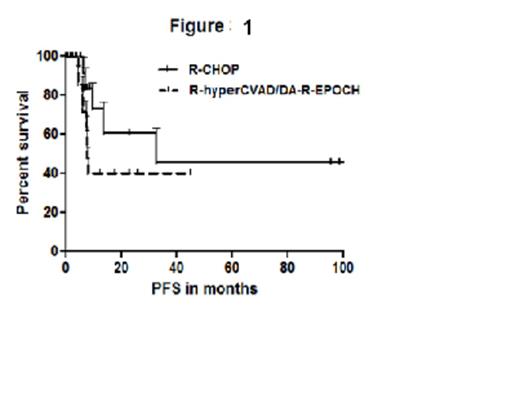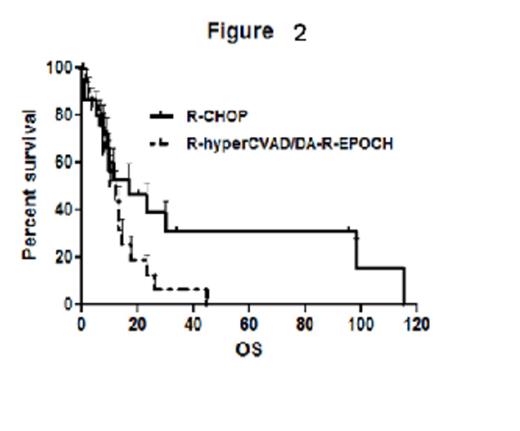Abstract
Double-hit (DH) diffuse large B cell lymphomas (DLBCL), characterized by concurrent translocations involving MYC and BCL2, or BCL6, portend to have an aggressive clinical course. Recent studies have highlighted the fact that DH lymphomas are resistant to standard R-CHOP or experience a short disease free interval. There is however limited data evaluating patient outcomes with alternative therapy that include aggressive regimens often used to treat high grade lymphoma.
Five hundred sixty patients (pts) diagnosed with DLBCL at a single institution between January 2004 and December 2012 were included in our analysis after obtaining IRB approval. Descriptive statistics, Wilcoxon signed rank sum test and Kaplan-Meier analysis were performed using SPSS.19 software.
Of the 560 pts, 34 were confirmed as DH based on FISH analysis. The median age at diagnosis was 63 yrs (range 36-87). Twenty pts (59%) were male. Thirty-one pts (91%) were Caucasian. Fourteen pts (53%) had an Eastern Cooperative Oncology Group performance status of 2-3. Thirty pts (89%) had advanced stage disease (stages III and IV). Thirteen pts (38%) had bone marrow involvement, and twenty-six pts (76%) had more than one extranodal site. The majority of pts (70%) had high intermediate or high risk based on the International Prognostic Index (IPI). Of the 34 pts, 15 (46%) received R-CHOP, 6 (18%) received R-Hyper CVAD/Ara-C/MTX, 8 (24%) received DA-R-EPOCH and 2 (6%) received other aggressive forms of chemotherapy. Two pts died before any therapy was initiated. Ten pts (29%) received central nervous system prophylaxis. Five pts (15%) underwent stem cell transplant, 2 of which in CR1. Twenty-eight pts (82%) were alive at the time of analysis. At a median follow up of one year, the median overall survival (OS) of all pts was 12.2 months. The median OS was 16.8 months for pts who received R-CHOP and 12.2 months for pts receiving other aggressive chemotherapy (P=0.07) (figure 1). The progression free survival for pts who received R-CHOP was 32.6 months as compared with 7.6 months in pts treated with R-hyper CVAD/Ara-C/MTX or DA-R-EPOCH. This was not statistically significant (P=0.44) (figure 2). In addition, there was no significant difference in disease free interval between the two groups of patients.
Our data suggests that prognosis of patients with DH-DLBCL remains poor independently of the chemotherapy administered, whether conventional R-CHOP or more aggressive regimens such as R-HyperCVAD or DA-R-EPOCH. Durable long term remission with R-CHOP is still possible in a minority of patients. There is a need to modify and incorporate novel agents in the initial treatment strategy for DH-DLBCL.
No relevant conflicts of interest to declare.
Author notes
Asterisk with author names denotes non-ASH members.



